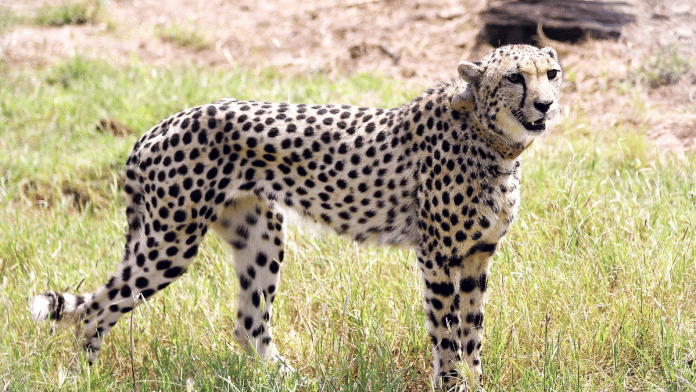New Delhi: Though the Mukundra Hills Tiger Reserve in Rajasthan is one of the six potential sites for Project Cheetah, the site, for now, is not suitable to accommodate the relocated big cats from Namibia, the central government has informed the Supreme Court.
In an affidavit filed before the top court Monday evening, the National Tiger Conservation Authority (NTCA) cited four reasons why Mukundra is not in a position to accommodate the animal at present.
The NTCA’s explanation comes in the wake of the top court’s advice to the central government to rise above politics and consider shifting a few cheetahs to Rajasthan. A bench led by Justice B.R. Gavai had expressed concern over the death of three cheetahs in Kuno, Madhya Pradesh, when it made the suggestion.
According to the document submitted by the NTCA, which ThePrint has seen, Mukundra has witnessed five tiger deaths/disappearances in a short span of time, some of which seemed to be caused by tick and parasite infection. One of the deceased tigers was a tigress who was reintroduced in Mukundra and reportedly died in May.
The affidavit also stated that there are many feral cattle in Mukundra that carry a high amount of parasitic load, which can pose a threat to the cheetahs’ survival. Furthermore, the data shows that 57 per cent of the frontline staff positions are vacant in Mukundra, the affidavit added.
In addition, it suggested that natural prey density was low in Mukundra and there was a need for prey-base augmentation. “Therefore, it is respectfully submitted that until or unless the necessary steps are not taken to address these issues, cheetahs cannot be translocated to the Mukundra under current circumstances,” the affidavit submitted.
The same bench of the apex court is likely to take up the matter Tuesday.
Also Read: Fate of ‘Project Cheetah’ and Congress-AAP ‘on the same path’
The action plan
The affidavit allayed the court’s impression that political considerations weighed in while preparing the action plan.
It revealed that Mukundra Hills Tiger Reserve is one of the six national parks that have been identified for cheetah introduction. The others are Kuno National Park, Gandhi Sagar Wildlife Sanctuary and Nauradehi Wildlife Sanctuary in Madhya Pradesh, and Shahgarh Bulge and Bhainsrorgarh Wildlife Sanctuary in Rajasthan.
However, introduction of cheetahs in these sites would depend upon continued availability of the animal from African countries as well as the status of habitat, prey base and protection mechanism on the ground, the affidavit said.
All the alternative sites, including Mukundra, NTCA maintained, would be prepared in a phased-manner based on the above-mentioned factors and according to the advice of the steering committee, which is supervising the implementation of the action plan.
For now, the authority informed the court that it has gone ahead to develop the Shivpuri-Sheopur-Kuno landscape in line with its landscape management plan guidelines. Hence, on 28 June, it wrote a letter to Madhya Pradesh government, asking it to add 253 square kilometres of Shivpuri, 159 square kilometres of Sheopur divisions and 150 square kilometres of Heerupur wildlife sanctuary to the area earmarked for cheetah reintroduction.
This was done after a meeting between the central and state government officials on 29 May. The other issues that were discussed during the meeting included the creation of a dedicated Cheetah protection force and augmentation of the forest staff in Kuno.
‘Cheetahs death natural’
On the deaths of cheetahs in Kuno, the affidavit reiterated the stand that they were natural and that they did not die due to unnatural reasons, such as poaching, snaring, poisoning, road hits, electrocution etc.
According to the NTCA’s submission, the deaths were “troubling” but not “unduly alarming”.
This is because, according to scientific awareness, cheetahs in general have very low survival rates, which is 50 per cent in adults, even in non-introduced populations, it said, adding, “In the case of the introduced population, the survival rates are much lower, taking other variables into account. This may lead to about 10 per cent survival in cubs.”
The affidavit included a chart that gives causes for the reported deaths. It assured the court that regular monitoring was being done in consultation with international cheetah experts.
NTCA affidavit also responded to a prey analysis report prepared by veteran conservationist Y.V. Jhala in which the former dean of Wildlife Institute of India (WII) has claimed that the population of chital — a wild prey for cheetah — in Kuno is only 15 animals per square kilometre.
However, in his earlier assessment report of January 2022 — which became the basis for introduction of cheetah in Kuno — Jhala had said chital is the most abundant wild prey there with a population density of 38.48 individuals per square kilometre. Cheetah was accordingly introduced in Kuno a few months later.
The affidavit said that Jhala’s second report was released after he retired from service. Calling it a discrepancy, the affidavit added the central government has taken immediate steps to address it and a fresh prey assessment is currently underway in Kuno National Park.
Jhala had played a significant role in designing the programme and bringing the cheetahs to India. However, in March this year, the government terminated his contract with the WII as it reduced his two-year extension as a dean and senior scientist with the institute to one year, which ended on 28 February, 2023.
Information about Jhala’s second assessment report was given to the court by another conservationist M.K. Ranjitsinh, who has raised questions about the manner in which the central government is handling Project Cheetah.
(Edited by Richa Mishra)
Also Read: Cheetah is India’s new conservation icon after tiger. It can save grasslands






